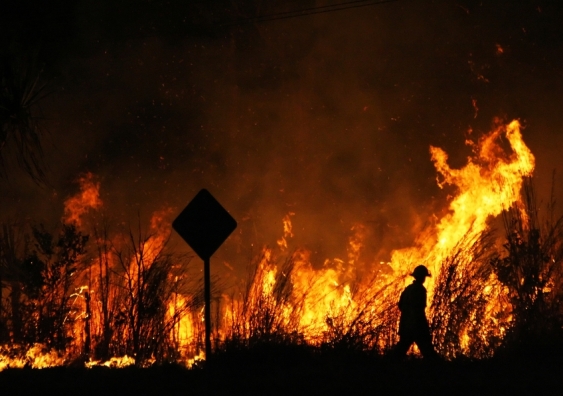Beyond Conformity: Enhancing Residential Property Security with an In-depth BAL Report
The Value of Bushfire Administration in Fire Security
In the world of fire security, the value of reliable bushfire administration can not be underrated. As neighborhoods around the world grapple with raising circumstances of wildfires, the proactive strategy to stop and reducing these natural disasters via tactical bushfire administration approaches has arised as an essential aspect. Past the instant hazard to human life and property, the interaction in between bushfire administration and eco-friendly preservation, community involvement, and environment modification postures complex obstacles that need comprehensive services.
Value of Proactive Bushfire Prevention
Proactive bushfire avoidance strategies are crucial in reducing the ravaging impacts of wildfires on ecological communities and communities. One crucial element of positive bushfire avoidance is gas management.
Enlightening the public on fire safety and security techniques and advertising area understanding about the value of bushfire avoidance are important parts of positive methods. Ultimately, aggressive bushfire prevention plays a substantial duty in safeguarding communities and communities from the devastating impacts of wildfires.
Role of Community Engagement in Fire Security
Engaging the neighborhood in fire defense efforts is indispensable to improving the effectiveness of aggressive bushfire avoidance strategies. Community engagement plays a vital duty in promoting a collective understanding of the threats posed by bushfires and the significance of preparedness steps. By entailing local residents, authorities can share important details on fire safety and security practices, emptying procedures, and very early warning systems, empowering people to take aggressive actions to protect their lives and residential or commercial properties.
Additionally, neighborhood interaction initiatives assist build durability within neighborhoods, promoting a sense of unity and shared obligation in mitigating fire risks. Through workshops, training sessions, and neighborhood occasions, locals can discover exactly how to produce defensible spaces around their homes, minimize fire fuel loads, and recognize prospective dangers. By promoting a society of preparedness and collaboration, neighborhoods can enhance their ability to respond effectively to bushfire emergencies, minimizing the impact on properties and lives. Eventually, community involvement is a foundation of detailed fire protection approaches, stressing the importance of collective action in securing at risk locations from the hazard of bushfires.
Significance of Wildlife Preservation in Bushfire Monitoring
Preservation of wildlife plays an essential duty in effective bushfire administration techniques, guaranteeing the defense of varied communities and biodiversity in fire-prone regions. Wild animals conservation is vital as it adds to the overall resilience of ecosystems, helping in their capability to recover and endure from the effect of bushfires. By conserving habitats and safeguarding various varieties, the natural equilibrium within these ecological communities is kept, which is crucial for their long-term health and wellness and sustainability.
In addition, wildlife conservation additionally aids in reducing the risk and intensity of bushfires. Healthy environments with unspoiled wild animals populaces can work as natural firebreaks, decreasing the spread of fires and limiting their devastating capacity (Bushfire Management Plan). Particular Look At This pet species, like delving animals or birds that spread out seeds, play distinct functions in stopping fires or helping in the post-fire regeneration of habitats
Integrating wild animals conservation right into bushfire administration methods is not just essential for protecting biodiversity but additionally for promoting the overall health and wellness and strength of ecological communities in the face of increasing fire risks.
Advantages of Strategic Fuel Decrease Programs
Tactically applying fuel reduction programs is essential in alleviating the threat and effect of bushfires in fire-prone regions. These programs include controlled burning, mechanical clearing up, and other approaches to decrease the amount of combustible plant life readily available to fuel wildfires. By purposefully decreasing gas lots in essential areas, such as close to property neighborhoods or important facilities, the strength and spread of bushfires can be dramatically reduced.
Among the primary advantages of fuel reduction programs is the enhancement of general fire durability in an ecosystem. By developing calculated gas breaks and reducing the continuity of plants, these programs help to interrupt the course of a bushfire, making it simpler for firemans to snuff out the blaze and contain. In addition, fuel reduction programs can safeguard biodiversity by preventing exceedingly intense fires that can ravage habitats and threaten wild animals populaces.
Furthermore, these programs can likewise guard human lives and home by lowering the a knockout post threat of tragic fires that position a substantial risk to neighborhoods. Ultimately, critical gas decrease programs play a critical role in aggressive bushfire management and promoting a much safer setting for both individuals and nature.
Impact of Climate Modification on Bushfire Risk

Greater temperature levels cause drier plants, making it much more prone to ignition. Decreased rains in certain regions prolongs drought conditions, even more increasing the flammability of the landscape. Additionally, the altering environment has altered wind patterns and atmospheric problems, bring about even more erratic fire habits and fast fire spread.
As the climate continues to alter, the regularity and strength of bushfires are anticipated to rise, demanding a positive and flexible approach to bushfire monitoring. Strategies have to progress to account for the changing danger landscape, integrating environment forecasts and considering long-term resilience in fire monitoring planning. Resolving the influence of environment adjustment on bushfire threat is crucial in establishing effective techniques to protect lives, building, and the environment.
Final Thought
Finally, aggressive bushfire prevention, area engagement, wildlife preservation, tactical gas reduction programs, and factor to consider of climate modification are important elements in effective fire security. By carrying out these techniques, we can much better handle bushfire risks and protect both human lives and the environment. BAL Assessment. It is necessary that stakeholders interact to focus on these measures to lessen the destructive impact of bushfires on environments and neighborhoods

As the environment proceeds to change, the regularity and strength of bushfires are expected to increase, demanding a adaptive and positive approach to bushfire administration.In conclusion, positive bushfire avoidance, community engagement, wild animals conservation, strategic gas decrease programs, and consideration of environment modification are crucial parts in efficient fire defense.